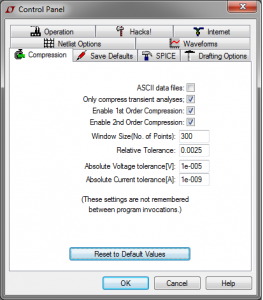Podcast: Play in new window | Download
Subscribe: Apple Podcasts | RSS
Welcome, LTspice guru, Mike Engelhardt of Linear Technology!
- Mike has been writing simulators since 1975! LTspice was his 3rd simulator, it is currently on version 4 and has been in the market for 14 years. You can download it for free here!
- Simulators are based upon numerical methods and approximating non-linearities. Mike defines SPICE as having common Jacobian (part of the solving matrix)
- The best simulators are not from software companies, they’re from the equipment manufacturers. The best measure of radar return from a war plane was from the plane manufacturer.
- Mike has optimized LTspice to run fast. This means it uses self authoring code, runs pipeline hot, compiles during the simulation and lots of other stuff Chris didn’t understand. This was all in order to remove processing overhead. It also means it’s energy efficient!
- Berkeley SPICE (the original) had lots of problems and discontinuities for the models contained within. It also was 200000 lines of code, but only 85000 lines of code were actually used. LTspice has closer to 500,000 lines of code.
- Intel CPUs are surprising, especially when running multithreaded. Mike recommends benchmarking all systems because of unknown possible behavior.
- Making transistor models is a difficult task and not advised for the layman. Either try to talk to the vendor to get one or approximate with a built in model.
- THE book on this topic is Semiconductor Device Modeling With Spice, 2nd edition.
- Some of the curve parameters are human readable (gate capacitance, beta, etc), others are not.
- Power transistor manufacturers do not normally provide models because the work of creating a good power transistor is different than a normal chip designer. To help switcher designs, LT made their own power transistor.
- Many of the switchers in LTspice are shown as Macromodel. These are encrypted versions of spice components that are written in a hardware description language.
- The LT3780 (which controls 4 switches and can do all types of switching regulation) has a digital engine in SPICE to replicate the state machine on board the chip.
- Though Berkeley SPICE is open source, LTspice is not. Mike did not think it was worth losing the competitive advantage.
- The control panel in LTspice has lots of knobs you can turn which will mess up your simulation. Some are worth it though:
- Solver: normal or alternate
- TRTOL: Default is 1 (Windows) or 2 (Mac), but the pros put it on 7 because they can handle possible glitches.

- Chris has played with the Gmin characteristic when working on sensitive designs.
- The hacks page allows you to turn on or off many of the corner cases that have been designed in over the years.
- Mike is currently on a 60 city Arrow seminar tour, on 6 continents! In the past Nu Horizons ran this tour (and Arrow bought them). You can see if Mike is coming to your city and sign up to attend!
Many thanks to Mike for visiting the show! More importantly thanks to him and his team for all the hard work on a tool that many of us use regularly and without hassle or payment! You can reach Mike directly at ltspice@linear.com (as always, please be respectful of our guests’ time)


Thank you Mike, Chris! Amazingly informational podcast 🙂 It’s a delight to listen to a professional, thank you sharing your expertize with the world!
And… keep up that good LT Spice work!
Great show! I have been using spice since the early 1980s. Back then, I used mostly PSpice. It was a DOS program, and had a separate graphical post processor called Probe. We wrote batch file scripts to rotate between a text editor for the netlist / sim commands, then running PSpice, then opening Probe to view results, then cycling back to edit the netlist again. No schematic capture for automated netlist generation back then (at least not that my company would pay for). We ran simulations on an IBM XT (6MHz 8086!), and had a sign over the door where the computer was located that said “Simulation Lab – where nanoseconds take hours”
It is actually slower than that. The XT was a 8088 running at 4.77MHz. The AT ran a 80286 at 6MHz with an optional 80287 match coprocessor. If you ran on a XT, I think nanoseconds would take days with 8087 math co-processor installed. LOL 😉
Very interesting to hear the voice behind the tool I use and love for being exactly that FAST and in large parts just simple to use. I come from the command line pedigree but as far as UI goes I’m not a fan of the very heavy and bloated SPICE tools that front load resources so much with useless UI gimmicks and LTSpice achieves this ideal UI I like in spades.
I would like to know what was the impetus for wanting to make it free? Also how does LTSpice stack up on AMD chips or is LTSpice highly optimized for Intel as it kind of sounded like? Chris asked a question I was thinking everytime I have seen only Mike’s name as an author. What happens if Mike is no longer with LT and god forbid the worst case. Although a bit morbid I chuckled at the dark humor reply. In any case how many people are on the Team?
This was a very enlightening discussion, and I was glad to have had the chance to listen in. His tour unfortunately does not make a Canadian stop.
I just started listening to your podcast. I am hearing a lot of pops in the audio that really distract from the listening experience. Are you aware of other people having this problem?
Love the content, though.
The problem must be with your system since we are both downloading the same Podcast file. The Podcast plays clean and clearly for me.
OK, I just tried on my desktop and some of the distortion is there – just not as severe. It is very noticeable in my car streaming audio over Bluetooth from an Android phone.
A pretty bad example should be audible at 10:04. When I listen in my car, the defects sound a lot worse for some reason.
Another faint click is audible at 9:11. These types of pops/clicks are audible pretty much throughout the podcast.
Yes, there was some audio noisiness this time around. We also try to do the best we can while talking to a remote guest (and not having them call in and be band limited). Unfortunately, this means we need to compromise from time to time and it appears you are hearing that now.
Great episode, I wish Mike had a twitter, seams like there would be very interesting things in it.
I liked this interview a lot. I have a few questions I wish were asked.
I would think the massive parallel architecture of a GPU would make life a lot easier. I wonder what he thinks of GPU based simulation?
I wonder what he thinks of Xyce?
https://xyce.sandia.gov/
Chris – On LTSpice and open source. There is a special backend in gEDA to produce netlists that will run in LTSpice. This might explain how you got confused.
What Mike described as self-autoring code is nowadays known as JIT-compilation and is used by the Java and .NET runtimes. It’s not black magic.